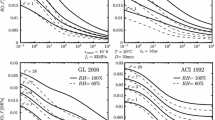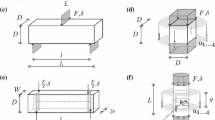Abstract
The preceding article describes a new multi-decade creep and shrinkage prediction model, labeled B4, which extends and improves the previous RILEM recommendation B3, and a separate article presents a new large worldwide database of laboratory data on creep, drying shrinkage and autogenous shrinkage. This article presents the general optimization concepts used to verify and calibrate Model B4. The main objective is multi-decade, even 100-year, prediction, which is what is needed for sustainable design of long-span bridges, tall buildings and other large concrete structures. Since the existing worldwide database is insufficient by far for purely experimental verification and calibration of multi-decade creep, the importance of choosing a model form that is theoretically and physically justified is emphasized. So is the choice of a model form that is able to fit closely individual broad-range creep and shrinkage curves for one and the same concrete, which are free of the huge obfuscating scatter due to differences in concrete composition. The development and calibration of the formulae for predicting the parameters of the creep and shrinkage equations from the composition and strength of concrete is described. An effective method for statistical optimization of the fits of a new database comprising thousands of laboratory test curves is presented. Various types of bias in the database are counteracted by data weighting. To predict and calibrate multi-decade creep, a method to combine the laboratory database with a database of excessive multi-decade deflections of large span bridges is outlined. This leads to a significant increase of the slope of the terminal trend of predicted creep in a logarithmic plot. Finally, the statistical approaches for using the hybrid laboratory-bridge database for multi-objective fit optimization and for Bayesian updating are explained and discussed.
















Similar content being viewed by others
References
Hubler MH, Wendner R, Bažant ZP (2014) Comprehensive database for concrete creep and shrinkage: analysis and recommendations for testing and recording. ACI (accepted)
Hubler MH, Wendner R, Bažant ZP (2014) Statistical justification of Model B4 for drying and autogenous shrinkage of concrete and comparisons to other models. RILEM Materials and Structures (accepted)
Wendner R, Hubler MH, Bažant ZP (2014) Statistical justification of Model B4 for multi-decade concrete creep and comparisons to other models using laboratory and bridge databases. RILEM Mater Struct (accepted)
Bažant ZP, Baweja S (1995) Creep and shrinkage prediction model for analysis and design of concrete structures: Model B3. RILEM Recommend Mater Struct 28:357–367 (Errata, 29:126)
Robert-Nicoud Y et al (2005) System identification through model composition and stochastic search. ASCE J Comput Civ Eng (JCCE) 19(3):239–247
Bažant ZP, Prasannan S (1989) Solidification theory for concrete creep: I. Formulation. J Eng Mech ASCE 115(8):1691–1703
Bažant ZP, Hauggaard AB, Baweja S, Ulm F-J (1997) Microprestress-solidification theory for concrete creep. I. Aging and drying effects. J Eng Mech ASCE 123(11):1188–1194
Bažant ZP, Hauggaard AB, Baweja S (1997) Microprestress-solidification theory for concrete creep. II. Algorithm and verification. J Eng Mech ASCE 123(11):1195–1201
Bažant ZP, Carreira D, Walser A (1975) Creep and shrinkage in reactor containment shells. J Struct Div Am Soc Civ Eng 101:2117–2131
Bažant ZP, Baweja S (2000) Creep and shrinkage prediction model for analysis and design of concrete structures: Model B3. In: Al-Manaseer A (ed) Adam Neville symposium: creep and shrinkage, structural design effects. American Concrete Institute (ACI SP194), Farmington Hills
Bažant ZP, Najjar LJ (1972) Non-linear water diffusion in non-saturated concrete. Mater Struct 5:3–20
Bažant ZP, Hubler MH, Wendner R (2014) Model B4 for creep, drying shrinkage and autogenous shrinkage of normal and high-strength concretes with multi-decade applicability. RILEM draft recommendation. TC-242-MDC MultiDecade Creep and Shrinkage of Concrete: Material model and structural analysis. RILEM Materials and Structures (accepted)
Fédération Internationale du Béton (2010) Structural concrete: textbook on behaviour, design and performance, vol 51. Int. du Béton, FIB-Féd
ACI Committee 209 (2008) Guide for modeling and calculating shrinkage and creep in hardened concrete. ACI Report 209.2R-08, Farmington Hills
Strauss A, Hoffmann S, Wendner R, Bergmeister K (2009) Structural assessment and reliability analysis for existing engineering structures, applications for real structures. Struct Infrastruct Eng 5(4):277–286
Wendner R, Strauss A, Guggenberger T, Bergmeister K, Teply B (2010) Approach for the assessment of concrete structures subjected to chloride induced deterioration. Beton- und Stahlbetonbau, 105. Heft 12, pp 778–786
Strauss A, Wendner R, Bergmeister K, Costa C (2013) Numerically and experimentally based reliability assessment of a concrete bridge subjected to chloride induced deterioration. J Infrastruct Syst 19(2):166–175
Müller HS, Hilsdorf HK (1990) Evaluation of the time-dependent behaviour of concrete: summary report on the work of the General Task Force Group No. 199. CEB (Copmité euro-internationale du béton), Lausanne, 201 pp
Troxell GE, Raphael JE, Davis RW (1958) Long-time creep and shrinkage tests of plain and reinforced concrete. In: Proceedings of ASTM, vol 58, pp 1101–1120
Russel HG, Larson SC (1989) Thirteen years of deformations in water tower place. ACI Struct J 86(2):182–191
Burg RG, Orst BW (1994) Engineering properties of commercially available high-strength concretes (including three year data). PCA Research and Development Bulletin RD104T, IL, Portland Cement Association, Skokie, p 58
Browne RD, Bamforth PP (1975) The long term creep of Wylfa P. V. concrete for loading ages up to 12 1/2 years. In: 3rd International conference on Structural Mechanics in Reactor Technology (SMiRT-3), paper H1/8, London
Hanson JA (1953) A ten-year study of creep properties of concrete. Concrete Lab. Report No. SP-38. US Department of the Interior, Bureau of Reclamation, Denver
Harboe EM et al (1958) A comparison of the instantaneous and the sustained modulus of elasticity of concrete, Concr. Lab. Rep. No. C-354. Division of Engineering Laboratories, US Department of the Interior, Bureau of Reclamation, Denver
Brooks JJ (2000) Elasticity, creep and shrinkage of concretes containing admixtures. ACI Journal SP 194, pp 283–360
Bažant ZP, Hubler MH, Yu Q (2011) Pervasiveness of excessive segmental bridge deflections: wake-up call for creep. ACI Struct J 108(6):766–774
Bažant ZP, Li G-H (2008) Unbiased statistical comparison of creep and shrinkage prediction models. ACI Mater J 105(6):610–621
Tofallis C (2008) Least squares percentage regression. J Mod Appl Stat Methods 7:526–534
Bažant ZP, Panula L (1978–1979) Practical prediction of time-dependent deformations of concrete. Mater Struct (11) Part I, Shrinkage, pp 307–316. Part II, Basic creep, pp 317–328. Part III, Drying creep, pp 415–424. Part IV, Temperature effect on basic creep, pp 425–434
Bažant ZP, Yu Q, Li, G-H (2012) Excessive long-time deflections of collapsed prestressed box girders: II. Numerical analysis and lessons learned. ASCE J Struct Eng 138(6):687–696
Yu Q, Bažant ZP, Wendner R (2012) Improved algorithm for efficient and realistic creep: analysis of large creep-sensitive concrete structures. ACI Struct J 109(5):665–676
Wendner R, Tong T, Strauss A, Yu Q (2014) A case study on correlations of axial shortening and deflection with concrete creep asymptote in segmentally-erected prestressed box girders. Struct Infrastruct Eng (in press)
Buljak V, Cocchetti G, Cornaggia A, Garbowski T, Maier G, Novati G (2013) Mechanical characterizations of materials and structural diagnoses by inverse analyses. Book chapter draft
Coleman TF, Li Y (1996) An interior, trust region approach for nonlinear minimization subject to bounds. SIAM J Optim 6:418–445
Conn AR, Gould NIM, Toint PL (2000) Trust-region methods. Society for Industrial and Applied Mathematics, Philadelphia
Koh CG, Perry MJ (2009) Structural identification and damage detection using genetic algorithms. CRC Press, Boca Raton
Lazinica A (ed) (2009) Particle swarm optimization. InTech
Waszczyszyn Z (1999) Neural networks in the analysis and design of structures. Springer, Berlin
Hagan MT, Demuth HB, Beale MH (1996) Neural network design. PWS Publishing, Boston
Haykin S (1998) Neural networks: a comprehensive foundation. Prentice Hall, Upper Saddle River
Novak D, Lehky D (2004) Neural network based identification of material model parameters to capture experimental load-deflection curve. Acta Polytech 2006 44(5–6):110–116
Acker P, Bažant ZP, Chern JC, Huet C, Wittmann FH (1998) RILEM recommendation on measurement of time-dependent strains of concrete (prepared by Subcomm. 4 of RILEM Committee TC107-CSP). Mater Struct 31(212):507–512
Subcommittee RILEM, 4 (1998) Measurement of time-dependent strains of concrete. Mater Struct 31:507–512
Wittmann FH, Bazant ZP, Alou F, Kim JK (1987) Statistics of shrinkage test data. Cem Concr Aggreg ASTM 9(2):129–153
Vandamme M, Zhang Q, Carrier B, Ulm F-J, Pellenq R, van Damme H, Le Roy R, Zuber B, Gartner E, Termkhajornkit P (2013) Creep properties of cementitious materials from indentation testing: signification, influence of relative humidity, and analogy between C-S-H and clays. Keynote presentation. CONCREEP 9, Boston
FIB (1999) Structural concrete: textbook on behaviour, design and performance, updated knowledge of the CEB/FIP Model Code 1990. Bulletin No. 2, Fédération internationale du béton (FIB), Lausanne 1, pp 35–52
Gardner NJ, Lockman MJ (2001) Design provisions for drying shrinkage and creep of normal strength. ACI Mater J 98(2):159–167
Committee ACI 209, II (chaired by Branson DE) (1971) Prediction of creep, shrinkage and temperature effects in concrete structures. Designing for creep, shrinkage and temperature. ACI SP-27, Detroit, pp 51–93
Ang AH-S, Tang WH (2007) Probability concepts in engineering planning and design, basic principles. Wiley, New York
Bayes T (1964) An essay toward solving a problem in the doctrine of chances. Philos Trans Lond 53:376–398
Deming WE (1940) Facsimile of two papers by Bayes. Department of Agriculture, Washington, DC
Strauss A, Wendner R, Frangopol DM, Bergmeister K (2012) Influence line- model correction approach for the assessment of engineering structures using novel monitoring techniques. Smart Struct Syst 9(1):1–20
Strauss A, Wendner R, Bergmeister K, Reiterer M, Horvatits J (2011) Monitoring and influence lines based performance indicators. Beton- und Stahlbetonbau, 106. Heft 4, pp 231–240
Acknowledgments
Financial support from the U.S. Department of Transportation, provided through Grant 20778 from the Infrastructure Technology Institute of Northwestern University, is gratefully appreciated. The first author thanks the Austrian Science Fund (FWF) for additional support in the form of the Erwin–Schrödinger Scholarship J3619-N13. Partial financial support by the Austrian Federal Ministry of Economy, Family and Youth and the National Foundation for Research, Technology and Development is gratefully acknowledged.
Author information
Authors and Affiliations
Corresponding author
Rights and permissions
About this article
Cite this article
Wendner, R., Hubler, M.H. & Bažant, Z.P. Optimization method, choice of form and uncertainty quantification of Model B4 using laboratory and multi-decade bridge databases. Mater Struct 48, 771–796 (2015). https://doi.org/10.1617/s11527-014-0515-0
Received:
Accepted:
Published:
Issue Date:
DOI: https://doi.org/10.1617/s11527-014-0515-0




